PORSCHE CAYMAN 2006 1.G Owner's Manual
Manufacturer: PORSCHE, Model Year: 2006, Model line: CAYMAN, Model: PORSCHE CAYMAN 2006 1.GPages: 280, PDF Size: 4.89 MB
Page 21 of 280
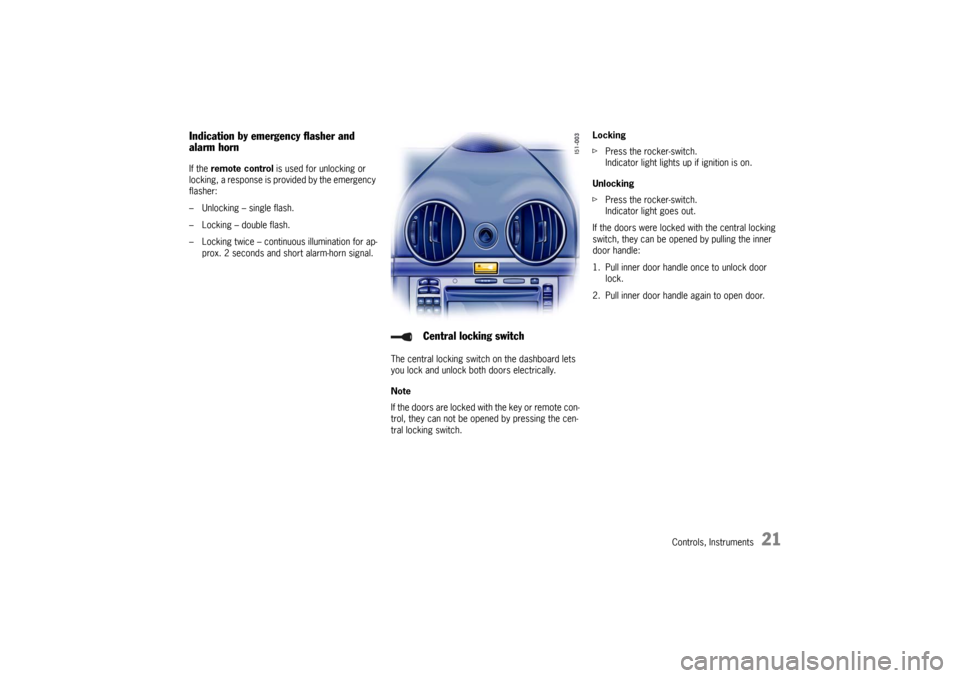
Controls, Instruments
21
Indication by emergency flasher and
alarm horn If the remote control is used for unlocking or
locking, a response is provided by the emergency
flasher:
– Unlocking – single flash.
– Locking – double flash.
– Locking twice – continuous illumination for ap-
prox. 2 seconds and short alarm-horn signal.
The central locking switch on the dashboard lets
you lock and unlock both doors electrically.
Note
If the doors are locked with the key or remote con-
trol, they can not be opened by pressing the cen-
tral locking switch. Locking
fPress the rocker-switch.
Indicator light lights up if ignition is on.
Unlocking
fPress the rocker-switch.
Indicator light goes out.
If the doors were locked with the central locking
switch, they can be opened by pulling the inner
door handle:
1. Pull inner door handle once to unlock door
lock.
2. Pull inner door handle again to open door.
Central locking switch
Page 22 of 280

22
Controls, Instruments
Automatic door locking Your authorized Porsche dealer can program di-
verse types of automatic door locking in the con-
trol unit of the central locking system.
Ty p e 1
Doors lock automatically when the ignition is
switched on.
Ty p e 2
Doors lock automatically when a speed of
3 - 6 mph (5 - 10 km/h) is exceeded.
Ty p e 3
Doors lock automatically when the ignition is
switched on. If doors are opened with the engine
running, they lock again automatically when a
speed of 3 - 6 mph (5 - 10 km/h) is exceeded.
Ty p e 4
The doors do not lock automatically. Note
Automatically locked doors can be unlocked with
the central locking button or opened by pulling on
the inside door handle twice.
On vehicles with the Sport Chrono package Plus,
the PCM can be used to activate automatic door
locking.
fPlease observe the chapter “Individual Memo-
ry” in the separate PCM operating instructions.
Warning!
In an emergency situation where you need to
exit the car through an automatically locked
door, remember the following procedure to
open the door.
fUnlock the doors by pressing the central lock-
ing button or
fpull the inside door handle twice to open the door.
Fault indication A double horn signal during locking indicates a
defect in the central locking or alarm system.
Have the defect remedied at an authorized
Porsche dealer. Overload protection If the central locking system is operated more
than ten times within a minute, further operation is
blocked for 15 seconds.
Page 23 of 280

Controls, Instruments
23
Doors If the door windows are closed, they will be auto-
matically opened by a few millimeters when the
doors are opened and, when the doors are closed,
they will be closed again.
This makes it easier to open and close the doors
and protects the seals.
fTherefore, you should pull the door handle
slowly so that the door window can be lowered
before the door is opened.
Opening doors from outside fUnlock vehicle with the remote control.
fPull the door handle A slowly so that the door
window can be lowered before the door is
opened. Opening unlocked doors from inside fPull the door handle B slowly so that the door
window can be lowered before the door is
opened.
Opening locked doors from inside fSlowly pull door handle B twice.
fPlease observe the chapter “LOCKING CONDI-
TIONS” on Page 20. Door storage tray Opening storage tray
fOpen the cover.
Keep the door storage tray C closed while driving
for safety reasons.
Page 24 of 280
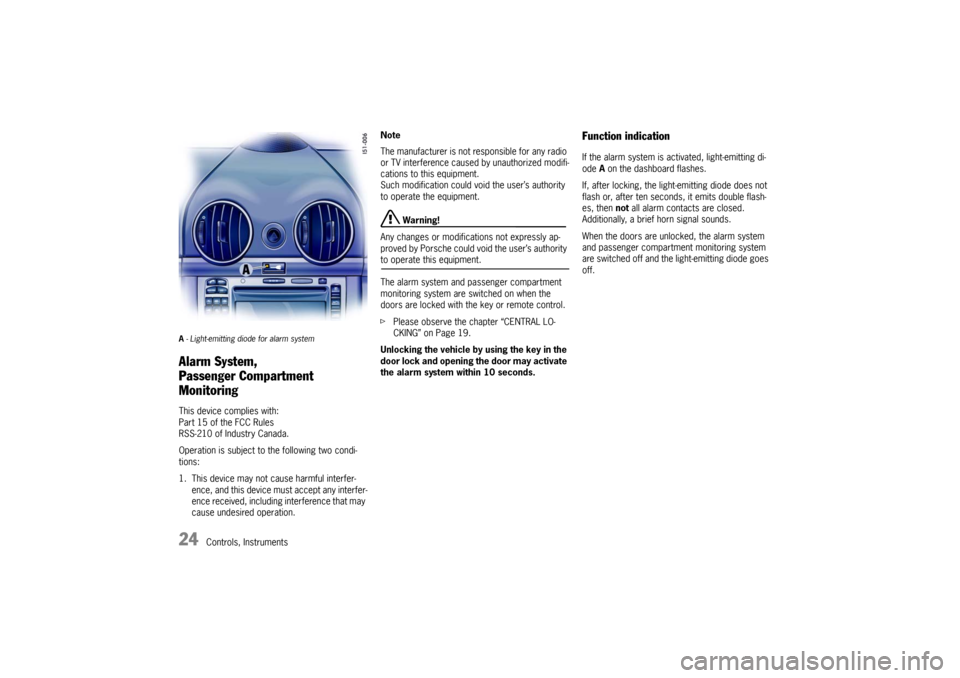
24
Controls, Instruments
A - Light-emitting diode for alarm system Alarm System,
Passenger Compartment
Monitoring This device complies with:
Part 15 of the FCC Rules
RSS-210 of Industry Canada.
Operation is subject to the following two condi-
tions:
1. This device may not cause harmful interfer-
ence, and this device must accept any interfer-
ence received, including interference that may
cause undesired operation.Note
The manufacturer is not responsible for any radio
or TV interference caused by unauthorized modifi-
cations to this equipment.
Such modification could void the user’s authority
to operate the equipment.
Warning!
Any changes or modifications not expressly ap-
proved by Porsche could void the user’s authority
to operate this equipment.
The alarm system and passenger compartment
monitoring system are switched on when the
doors are locked with the key or remote control.
fPlease observe the chapter “CENTRAL LO-
CKING” on Page 19.
Unlocking the vehicle by using the key in the
door lock and opening the door may activate
the alarm system within 10 seconds.
Function indication If the alarm system is activated, light-emitting di-
ode A on the dashboard flashes.
If, after locking, the light-emitting diode does not
flash or, after ten seconds, it emits double flash-
es, then not all alarm contacts are closed.
Additionally, a brief horn signal sounds.
When the doors are unlocked, the alarm system
and passenger compartment monitoring system
are switched off and the light-emitting diode goes
off.
Page 25 of 280

Controls, Instruments
25
When the alarm is armed, the following
areas are monitored –Doors
– Front and rear lids
– Glove compartment
– Passenger compartment
If one of these alarm contacts is interrupted, the
alarm horn sounds for approximately 3 minutes.
Additionally, the emergency flasher and the pas-
senger compartment light flash for approximately
four minutes.
When the alarm is triggered, the light-emitting di-
ode changes over to double flashes.
In order not to limit the action range of the passen-
ger compartment monitoring system:
fDo not fold the backrests forward.
Deactivating the passenger compartment
monitoring system for one locking
process If a person or animal remains in the car while it is
locked, the passenger compartment monitoring
system must be switched off.
fQuickly lock car twice.
The doors are locked but can be opened from
the inside:
1. Pull inner door handle once to unlock door
lock.
2. Pull inner door handle again to open door.
Note
Inform any person remaining in the car that the
alarm system will be triggered if the door is
opened.
Fault indication A double horn signal during locking indicates a
defect in the central locking or alarm system.
fHave the defect remedied at an authorized
Porsche dealer.
Page 26 of 280
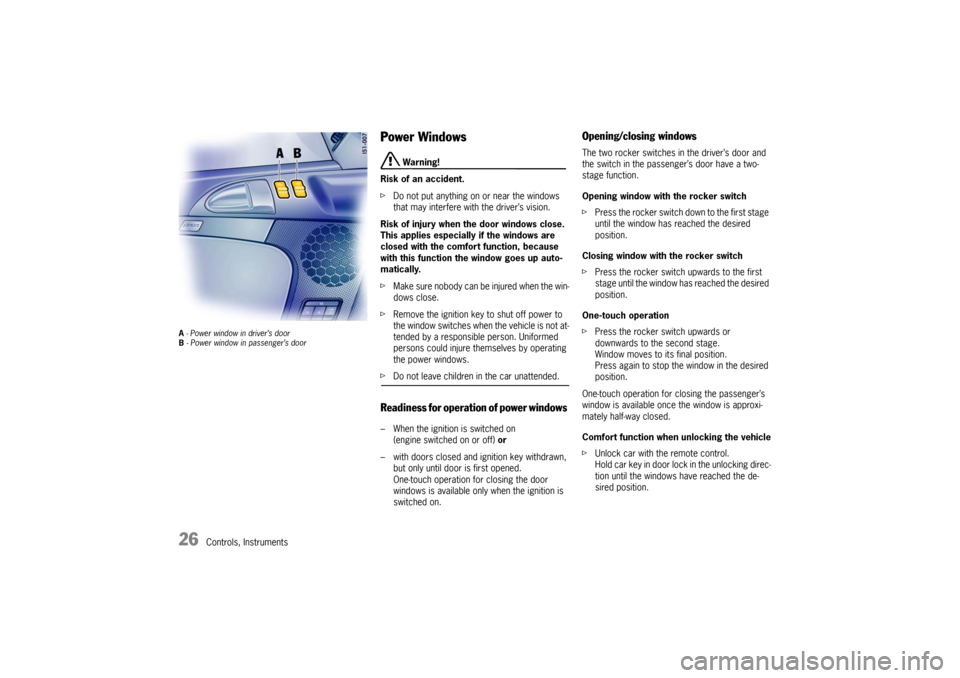
26
Controls, Instruments
A - Power window in driver’s door
B - Power window in passenger’s door
Power Windows
Warning!
Risk of an accident.
fDo not put anything on or near the windows
that may interfere with the driver’s vision.
Risk of injury when the door windows close.
This applies especially if the windows are
closed with the comfort function, because
with this function the window goes up auto-
matically.
fMake sure nobody can be injured when the win-
dows close.
fRemove the ignition key to shut off power to
the window switches when the vehicle is not at-
tended by a responsible person. Uniformed
persons could injure themselves by operating
the power windows.
fDo not leave children in the car unattended.Readiness for operation of power windows – When the ignition is switched on
(engine switched on or off) or
– with doors closed and ignition key withdrawn,
but only until door is first opened.
One-touch operation for closing the door
windows is available only when the ignition is
switched on.
Opening/closing windowsThe two rocker switches in the driver’s door and
the switch in the passenger’s door have a two-
stage function.
Opening window with the rocker switch
fPress the rocker switch down to the first stage
until the window has reached the desired
position.
Closing window with the rocker switch
fPress the rocker switch upwards to the first
stage until the window has reached the desired
position.
One-touch operation
fPress the rocker switch upwards or
downwards to the second stage.
Window moves to its final position.
Press again to stop the window in the desired
position.
One-touch operation for closing the passenger’s
window is available once the window is approxi-
mately half-way closed.
Comfort function when unlocking the vehicle
fUnlock car with the remote control.
Hold car key in door lock in the unlocking direc-
tion until the windows have reached the de-
sired position.
Page 27 of 280

Controls, Instruments
27
Closing door windowsfPress rocker switch A until the door window
has reached the desired position.
One-touch operation (with ignition on)
fPress rocker switch A briefly.
Window moves to its final position.
Press again to stop the window in the desired
position.
Anti-crushing protection If the door window is blocked during closing, it will
stop and open again by about an inch.
Warning!
Risk of severe personal injuries.
If the rocker switch “A” is pressed again with-
in 10
seconds of the window being blocked,
the window will close with its full closing
force. Anti-crushing protection is disabled.
fOnce the anti-crushing protection acts to stop
the window and opens it slightly, do not press
the rocker switch again within 10 seconds
without checking to make sure that nothing is
blocking the path of the window.The window will close with full closing force.
One-touch operation is disabled for 10 seconds
after blockage of a side window.
Automatic window lowering fPlease observe the chapter “DOORS” on Page
23.Storing end position of the windows If the battery is disconnected and reconnected,
the windows will not be raised automatically when
the door is closed.
1. Close the windows with the rocker switch
once.
2. Press front half of rocker switch again to store
the end position of the windows in the control
unit.
Page 28 of 280
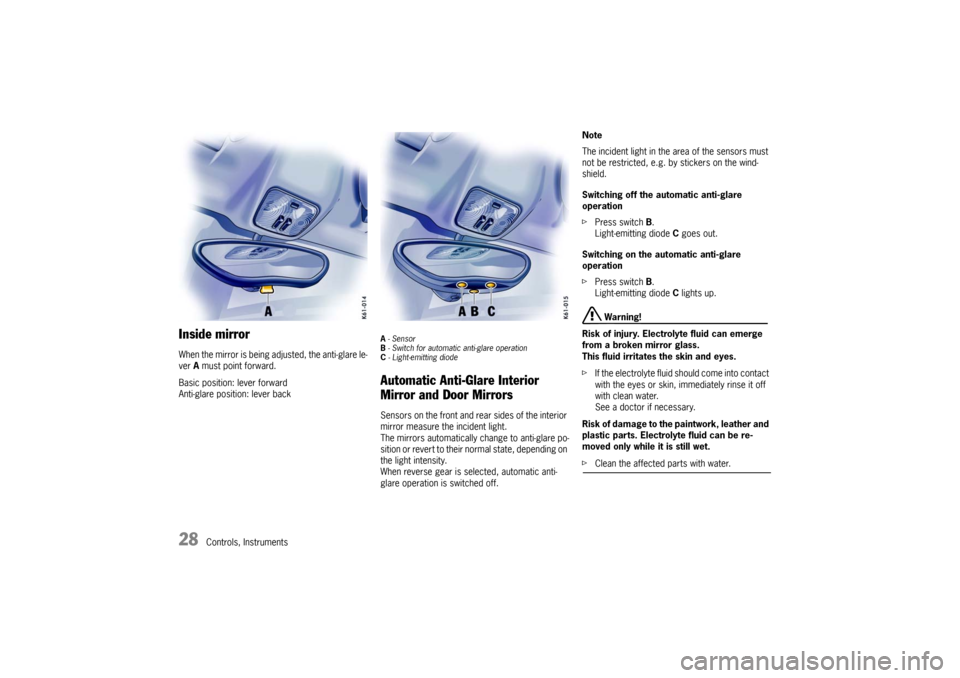
28
Controls, Instruments
Inside mirror When the mirror is being adjusted, the anti-glare le-
ver A must point forward.
Basic position: lever forward
Anti-glare position: lever back
A - Sensor
B - Switch for automatic anti-glare operation
C - Light-emitting diode Automatic Anti-Glare Interior
Mirror and Door Mirrors Sensors on the front and rear sides of the interior
mirror measure the incident light.
The mirrors automatically change to anti-glare po-
sition or revert to their normal state, depending on
the light intensity.
When reverse gear is selected, automatic anti-
glare operation is switched off. Note
The incident light in the area of the sensors must
not be restricted, e.g. by stickers on the wind-
shield.
Switching off the automatic anti-glare
operation
fPress switch B.
Light-emitting diode C goes out.
Switching on the automatic anti-glare
operation
fPress switch B.
Light-emitting diode C lights up.
Warning!
Risk of injury. Electrolyte fluid can emerge
from a broken mirror glass.
This fluid irritates the skin and eyes.
fIf the electrolyte fluid should come into contact
with the eyes or skin, immediately rinse it off
with clean water.
See a doctor if necessary.
Risk of damage to the paintwork, leather and
plastic parts. Electrolyte fluid can be re-
moved only while it is still wet.
fClean the affected parts with water.
Page 29 of 280
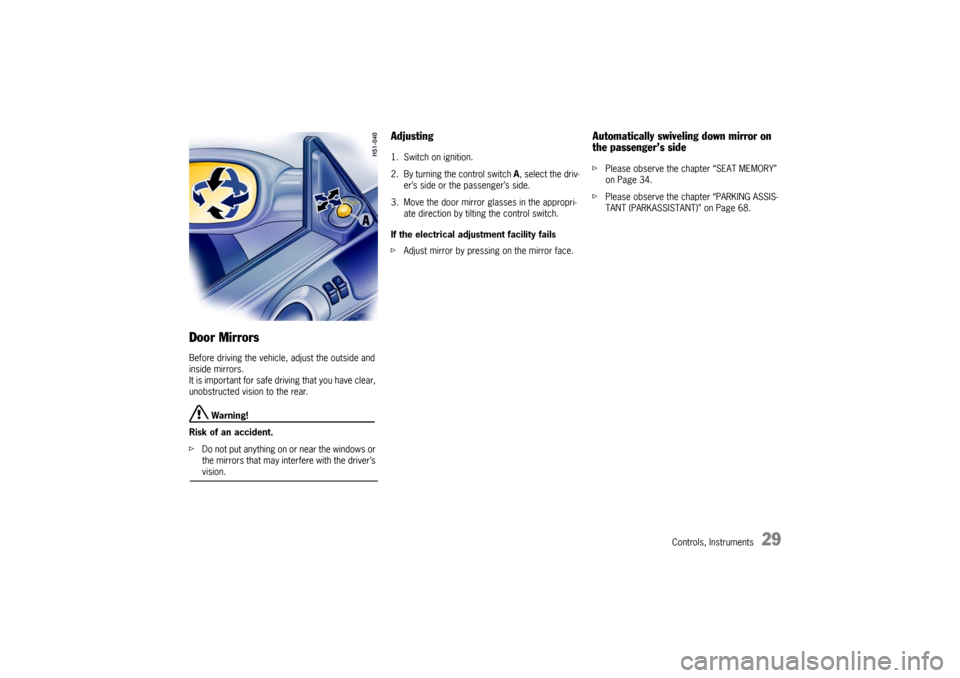
Controls, Instruments
29
Door Mirrors Before driving the vehicle, adjust the outside and
inside mirrors.
It is important for safe driving that you have clear,
unobstructed vision to the rear.
Warning!
Risk of an accident.
fDo not put anything on or near the windows or
the mirrors that may interfere with the driver’s vision.
Adjusting 1. Switch on ignition.
2. By turning the control switch A, select the driv-
er’s side or the passenger’s side.
3. Move the door mirror glasses in the appropri-
ate direction by tilting the control switch.
If the electrical adjustment facility fails
fAdjust mirror by pressing on the mirror face.
Automatically swiveling down mirror on
the passenger’s sidefPlease observe the chapter “SEAT MEMORY”
on Page 34.
fPlease observe the chapter “PARKING ASSIS-
TANT (PARKASSISTANT)” on Page 68.
Page 30 of 280
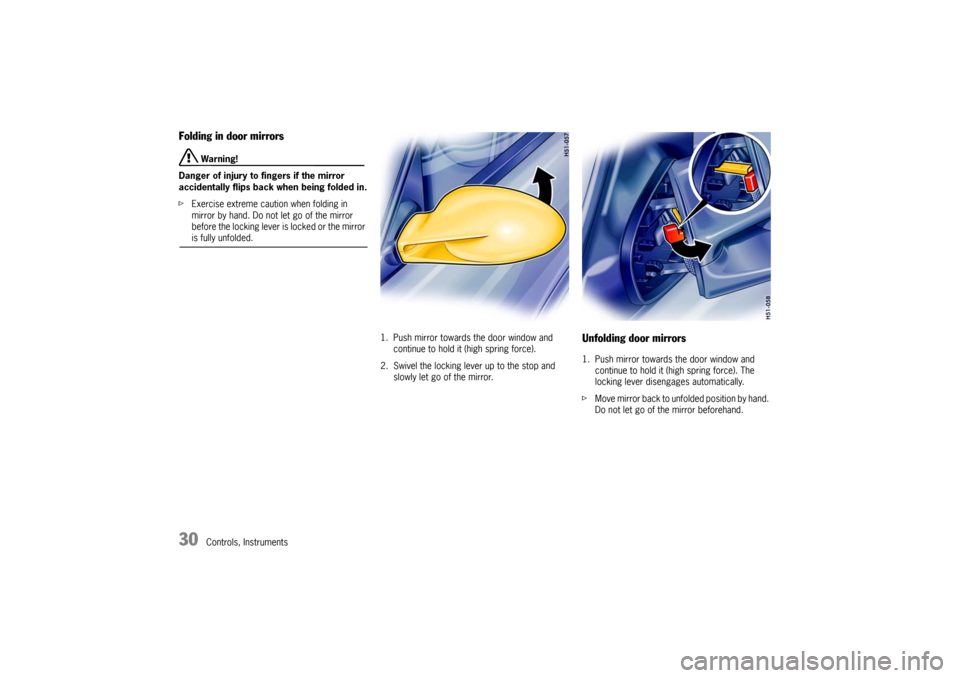
30
Controls, Instruments
Folding in door mirrors
Warning!
Danger of injury to fingers if the mirror
accidentally flips back when being folded in.
fExercise extreme caution when folding in
mirror by hand. Do not let go of the mirror
before the locking lever is locked or the mirror is fully unfolded.
1. Push mirror towards the door window and
continue to hold it (high spring force).
2. Swivel the locking lever up to the stop and
slowly let go of the mirror.
Unfolding door mirrors1. Push mirror towards the door window and
continue to hold it (high spring force). The
locking lever disengages automatically.
fMove mirror back to unfolded position by hand.
Do not let go of the mirror beforehand.